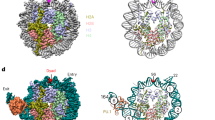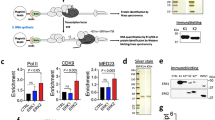Abstract
Oncoprotein E2a-Pbx1 contains the N-terminal transactivation domains of E2a and the majority of the homeodomain protein, Pbx1. Using recombinant proteins, both Pbx1 and E2a-Pbx1 heterodimerize with Hox proteins on bipartite elements, Pbx1 binding a 5′ TGAT core and Class I Hox proteins binding adjacent 3′ TAAT, TTAT, or TGAT cores. In contrast to these in vitro results, nuclear extracts from E2a-Pbx1-transformed cells assemble an abundant Pbx-containing complex on TGATTGAT that excludes E2a-Pbx1, suggesting that an uncharacterized in vivo partner discriminates between E2a-Pbx1 and Pbx proteins, distinguishing it from Hox proteins. Here, we describe the DNA-binding properties of this complex, and identify TGATTGAC (PCE; Pbx Consensus Element) as its optimal recognition motif. In vitro, the PCE fails to bind heterodimers of Class I Hox proteins plus either Pbx1 or E2a-Pbx1. Likewise, in vivo, the PCE fails to mediate cooperative transactivation by E2a-Pbx1 plus Class I Hox proteins. Thus, the PCE binds a Pbx dimer partner that behaves unlike Class I Hox proteins. Competition analysis indicates that the Pbx-containing complex that binds the PCE also binds the TGATTGAT Pbx-Hox element and binds promoter elements required for tissue-specific expression of a number of cellular genes. Thus, different Pbx partners dictate targetting of Pbx heterodimers to related DNA motifs that differ in the sequence of their 3′ half-sites, and E2a-Pbx1 heterodimerizes with only a subset of Pbx partners, restricting its potential DNA targets.
This is a preview of subscription content, access via your institution
Access options
Subscribe to this journal
Receive 50 print issues and online access
$259.00 per year
only $5.18 per issue
Buy this article
- Purchase on Springer Link
- Instant access to full article PDF
Prices may be subject to local taxes which are calculated during checkout
Similar content being viewed by others
Author information
Authors and Affiliations
Rights and permissions
About this article
Cite this article
Knoepfler, P., Kamps, M. The highest affinity DNA element bound by Pbx complexes in t(1;19) leukemic cells fails to mediate cooperative DNA-binding or cooperative transactivation by E2a-Pbx1 and Class I Hox proteins – evidence for selective targetting of E2a-Pbx1 to a subset of Pbx-recognition elements. Oncogene 14, 2521–2531 (1997). https://doi.org/10.1038/sj.onc.1201097
Received:
Revised:
Accepted:
Issue Date:
DOI: https://doi.org/10.1038/sj.onc.1201097



